Evaluation of the Antibacterial Potential of Two Short Linear Peptides YI12 and FK13 against Multidrug-Resistant Bacteria
Abstract
1. Introduction
2. Results
2.1. YI12 and FK13 Display Notable Broad-Spectrum Antibacterial Activities
2.2. Safety and Stability Evaluation of YI12 and FK13
2.3. YI12 and FK13 Alter Membrane Permeability and Dissipate Membrane Potential
2.4. YI12 and FK13 Trigger the Production of ROS
3. Discussion
4. Experimental Section
4.1. Synthesis and Verification of Antimicrobial Peptides
4.2. Determination of Antibacterial Activity of AMPs
4.3. Time-Dependent Killing
4.4. Secondary Structure Determination
4.5. Analysis of Hemolytic Activity
4.6. Physiological Stability Determination of AMPs
4.6.1. Salt Ion and Serum Stability
4.6.2. pH and Temperature Stability
4.6.3. Protease Stability
4.6.4. Detection of Outer Membrane Integrity
4.6.5. Detection of Cell Membrane Permeability
4.6.6. Membrane Potential Detection
4.6.7. Reactive Oxygen Species (ROS) Measurement
4.7. Statistical Analysis
Author Contributions
Funding
Institutional Review Board Statement
Informed Consent Statement
Data Availability Statement
Conflicts of Interest
References
- Martens, E.; Demain, A.L. The antibiotic resistance crisis, with a focus on the United States. J. Antibiot. 2017, 70, 520–526. [Google Scholar] [CrossRef] [PubMed]
- Global burden of bacterial antimicrobial resistance in 2019: A systematic analysis. Lancet 2022, 399, 629–655. [CrossRef] [PubMed]
- Luepke, K.H.; Suda, K.J.; Boucher, H.; Russo, R.L.; Bonney, M.W.; Hunt, T.D.; Mohr, J.F., 3rd. Past, Present, and Future of Antibacterial Economics: Increasing Bacterial Resistance, Limited Antibiotic Pipeline, and Societal Implications. Pharmacotherapy 2017, 37, 71–84. [Google Scholar] [CrossRef] [PubMed]
- Das, P.; Sercu, T.; Wadhawan, K.; Padhi, I.; Gehrmann, S.; Cipcigan, F.; Chenthamarakshan, V.; Strobelt, H.; Dos Santos, C.; Chen, P.Y.; et al. Accelerated antimicrobial discovery via deep generative models and molecular dynamics simulations. Nat. Biomed. Eng. 2021, 5, 613–623. [Google Scholar] [CrossRef] [PubMed]
- Zhang, L.-j.; Gallo, R.L. Antimicrobial peptides. Curr. Biol. 2016, 26, R14–R19. [Google Scholar] [CrossRef]
- Duarte-Mata, D.I.; Salinas-Carmona, M.C. Antimicrobial peptides’ immune modulation role in intracellular bacterial infection. Front. Immunol. 2023, 14, 1119574. [Google Scholar] [CrossRef]
- Diamond, G.; Beckloff, N.; Weinberg, A.; Kisich, K.O. The roles of antimicrobial peptides in innate host defense. Curr. Pharm. Des. 2009, 15, 2377–2392. [Google Scholar] [CrossRef]
- Gan, B.H.; Gaynord, J.; Rowe, S.M.; Deingruber, T.; Spring, D.R. Correction: The multifaceted nature of antimicrobial peptides: Current synthetic chemistry approaches and future directions. Chem. Soc. Rev. 2022, 51, 792. [Google Scholar] [CrossRef]
- Nguyen, L.T.; Haney, E.F.; Vogel, H.J. The expanding scope of antimicrobial peptide structures and their modes of action. Trends Biotechnol. 2011, 29, 464–472. [Google Scholar] [CrossRef]
- Zhang, Q.Y.; Yan, Z.B.; Meng, Y.M.; Hong, X.Y.; Shao, G.; Ma, J.J.; Cheng, X.R.; Liu, J.; Kang, J.; Fu, C.Y. Antimicrobial peptides: Mechanism of action, activity and clinical potential. Mil. Med. Res. 2021, 8, 48. [Google Scholar] [CrossRef]
- Magana, M.; Pushpanathan, M.; Santos, A.L.; Leanse, L.; Fernandez, M.; Ioannidis, A.; Giulianotti, M.A.; Apidianakis, Y.; Bradfute, S.; Ferguson, A.L.; et al. The value of antimicrobial peptides in the age of resistance. Lancet Infect. Dis. 2020, 20, e216–e230. [Google Scholar] [CrossRef] [PubMed]
- Liu, Y.; Shi, J.; Tong, Z.; Jia, Y.; Yang, B.; Wang, Z. The revitalization of antimicrobial peptides in the resistance era. Pharmacol. Res. 2021, 163, 105276. [Google Scholar] [CrossRef] [PubMed]
- Shi, J.; Chen, C.; Wang, D.; Wang, Z.; Liu, Y. The antimicrobial peptide LI14 combats multidrug-resistant bacterial infections. Commun. Biol. 2022, 5, 926. [Google Scholar] [CrossRef] [PubMed]
- Pokorny, A.; Almeida, P.F. The Antibiotic Peptide Daptomycin Functions by Reorganizing the Membrane. J. Membr. Biol. 2021, 254, 97–108. [Google Scholar] [CrossRef] [PubMed]
- Botelho Sampaio de Oliveira, K.; Lopes Leite, M.; Albuquerque Cunha, V.; Brito da Cunha, N.; Luiz Franco, O. Challenges and advances in antimicrobial peptide development. Drug Disc. Today 2023, 28, 103629. [Google Scholar] [CrossRef]
- Wan, F.; Wong, F.; Collins, J.J.; de la Fuente-Nunez, C. Machine learning for antimicrobial peptide identification and design. Nat. Biomed. Eng. 2024, 2, 392–407. [Google Scholar] [CrossRef]
- Liang, Y.; Zhang, X.; Yuan, Y.; Bao, Y.; Xiong, M. Role and modulation of the secondary structure of antimicrobial peptides to improve selectivity. Biomater. Sci. 2020, 8, 6858–6866. [Google Scholar] [CrossRef]
- Maldonado, R.F.; Sá-Correia, I.; Valvano, M.A. Lipopolysaccharide modification in Gram-negative bacteria during chronic infection. FEMS Microbiol. Rev. 2016, 40, 480–493. [Google Scholar] [CrossRef]
- Yang, Z.; He, S.; Wang, J.; Yang, Y.; Zhang, L.; Li, Y.; Shan, A. Rational Design of Short Peptide Variants by Using Kunitzin-RE, an Amphibian-Derived Bioactivity Peptide, for Acquired Potent Broad-Spectrum Antimicrobial and Improved Therapeutic Potential of Commensalism Coinfection of Pathogens. J. Med. Chem. 2019, 62, 4586–4605. [Google Scholar] [CrossRef]
- Hoejholt, K.L.; Mužić, T.; Jensen, S.D.; Dalgaard, L.T.; Bilgin, M.; Nylandsted, J.; Heimburg, T.; Frandsen, S.K.; Gehl, J. Calcium electroporation and electrochemotherapy for cancer treatment: Importance of cell membrane composition investigated by lipidomics, calorimetry and in vitro efficacy. Sci. Rep. 2019, 9, 4758. [Google Scholar] [CrossRef]
- Klein, G.; Kobylak, N.; Lindner, B.; Stupak, A.; Raina, S. Assembly of lipopolysaccharide in Escherichia coli requires the essential LapB heat shock protein. J. Biol. Chem. 2014, 289, 14829–14853. [Google Scholar] [CrossRef] [PubMed]
- Vergalli, J.; Bodrenko, I.V.; Masi, M.; Moynié, L.; Acosta-Gutiérrez, S.; Naismith, J.H.; Davin-Regli, A.; Ceccarelli, M.; van den Berg, B.; Winterhalter, M.; et al. Porins and small-molecule translocation across the outer membrane of Gram-negative bacteria. Nat. Rev. Microbiol. 2020, 18, 164–176. [Google Scholar] [CrossRef]
- Berry, B.J.; Trewin, A.J.; Amitrano, A.M.; Kim, M.; Wojtovich, A.P. Use the Protonmotive Force: Mitochondrial Uncoupling and Reactive Oxygen Species. J. Mol. Biol. 2018, 430, 3873–3891. [Google Scholar] [CrossRef] [PubMed]
- Van Acker, H.; Coenye, T. The Role of Reactive Oxygen Species in Antibiotic-Mediated Killing of Bacteria. Trends Microbiol. 2017, 25, 456–466. [Google Scholar] [CrossRef] [PubMed]
- Vaishampayan, A.; Grohmann, E. Antimicrobials Functioning through ROS-Mediated Mechanisms: Current Insights. Microorganisms 2021, 10, 61. [Google Scholar] [CrossRef] [PubMed]
- Brynildsen, M.P.; Winkler, J.A.; Spina, C.S.; Macdonald, I.C.; Collins, J.J. Potentiating antibacterial activity by predictably enhancing endogenous microbial ROS production. Nat. Biotechnol. 2013, 31, 160–165. [Google Scholar] [CrossRef]
- Miller, W.R.; Arias, C.A. ESKAPE pathogens: Antimicrobial resistance, epidemiology, clinical impact and therapeutics. Nat. Rev. Microbiol. 2024, 22, 598–616. [Google Scholar] [CrossRef]
- de Breij, A.; Riool, M.; Cordfunke, R.A.; Malanovic, N.; de Boer, L.; Koning, R.I.; Ravensbergen, E.; Franken, M.; van der Heijde, T.; Boekema, B.K.; et al. The antimicrobial peptide SAAP-148 combats drug-resistant bacteria and biofilms. Sci. Transl. Med. 2018, 10, eaan4044. [Google Scholar] [CrossRef]
- Ma, Y.; Guo, Z.; Xia, B.; Zhang, Y.; Liu, X.; Yu, Y.; Tang, N.; Tong, X.; Wang, M.; Ye, X.; et al. Identification of antimicrobial peptides from the human gut microbiome using deep learning. Nat. Biotechnol. 2022, 40, 921–931. [Google Scholar] [CrossRef]
- Lei, J.; Sun, L.; Huang, S.; Zhu, C.; Li, P.; He, J.; Mackey, V.; Coy, D.H.; He, Q. The antimicrobial peptides and their potential clinical applications. Am. J. Transl. Res. 2019, 11, 3919–3931. [Google Scholar]
- Islam, M.Z.; Hossain, F.; Ali, M.H.; Yamazaki, M. Relationship between antimicrobial peptides-induced cell membrane damage and bactericidal activity. Biophys. J. 2023, 122, 4645–4655. [Google Scholar] [CrossRef] [PubMed]
- Yang, B.; Tong, Z.; Shi, J.; Wang, Z.; Liu, Y. Bacterial proton motive force as an unprecedented target to control antimicrobial resistance. Med. Res. Rev. 2023, 43, 1068–1090. [Google Scholar] [CrossRef] [PubMed]
- Dharmaraja, A.T. Role of Reactive Oxygen Species (ROS) in Therapeutics and Drug Resistance in Cancer and Bacteria. J. Med. Chem. 2017, 60, 3221–3240. [Google Scholar] [CrossRef] [PubMed]
- Humphries, R.; Bobenchik, A.M.; Hindler, J.A.; Schuetz, A.N. Overview of Changes to the Clinical and Laboratory Standards Institute Performance Standards for Antimicrobial Susceptibility Testing, M100, 31st Edition. J. Clin. Microbiol. 2021, 59, e0021321. [Google Scholar] [CrossRef]
- Lowe, G.; Stike, R.; Pollack, M.; Bosley, J.; O’Brien, P.; Hake, A.; Landis, G.; Billings, N.; Gordon, P.; Manzella, S.; et al. Nursing Blood Specimen Collection Techniques and Hemolysis Rates in an Emergency Department: Analysis of Venipuncture Versus Intravenous Catheter Collection Techniques. J. Emerg. Nurs. 2008, 34, 26–32. [Google Scholar] [CrossRef]

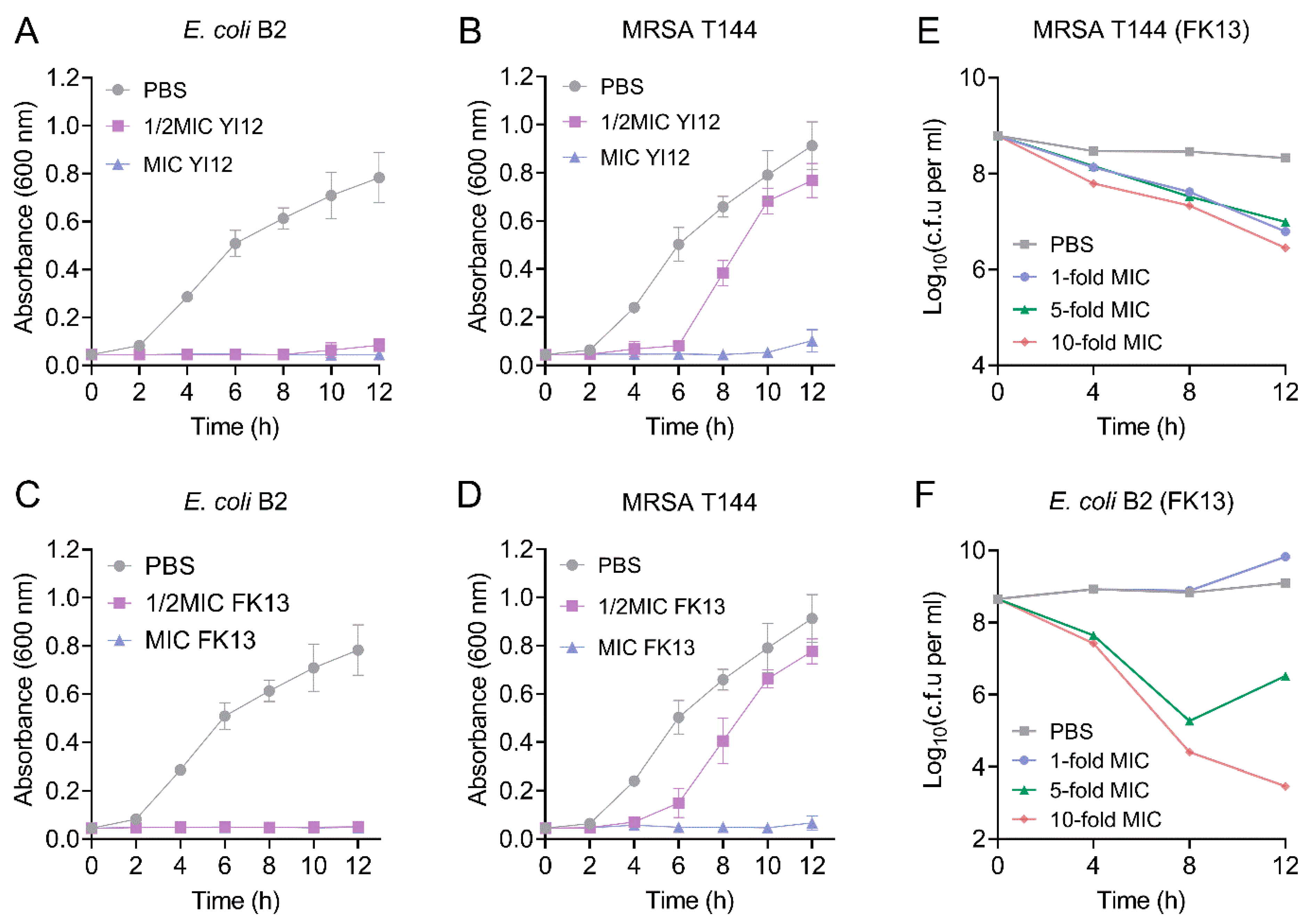
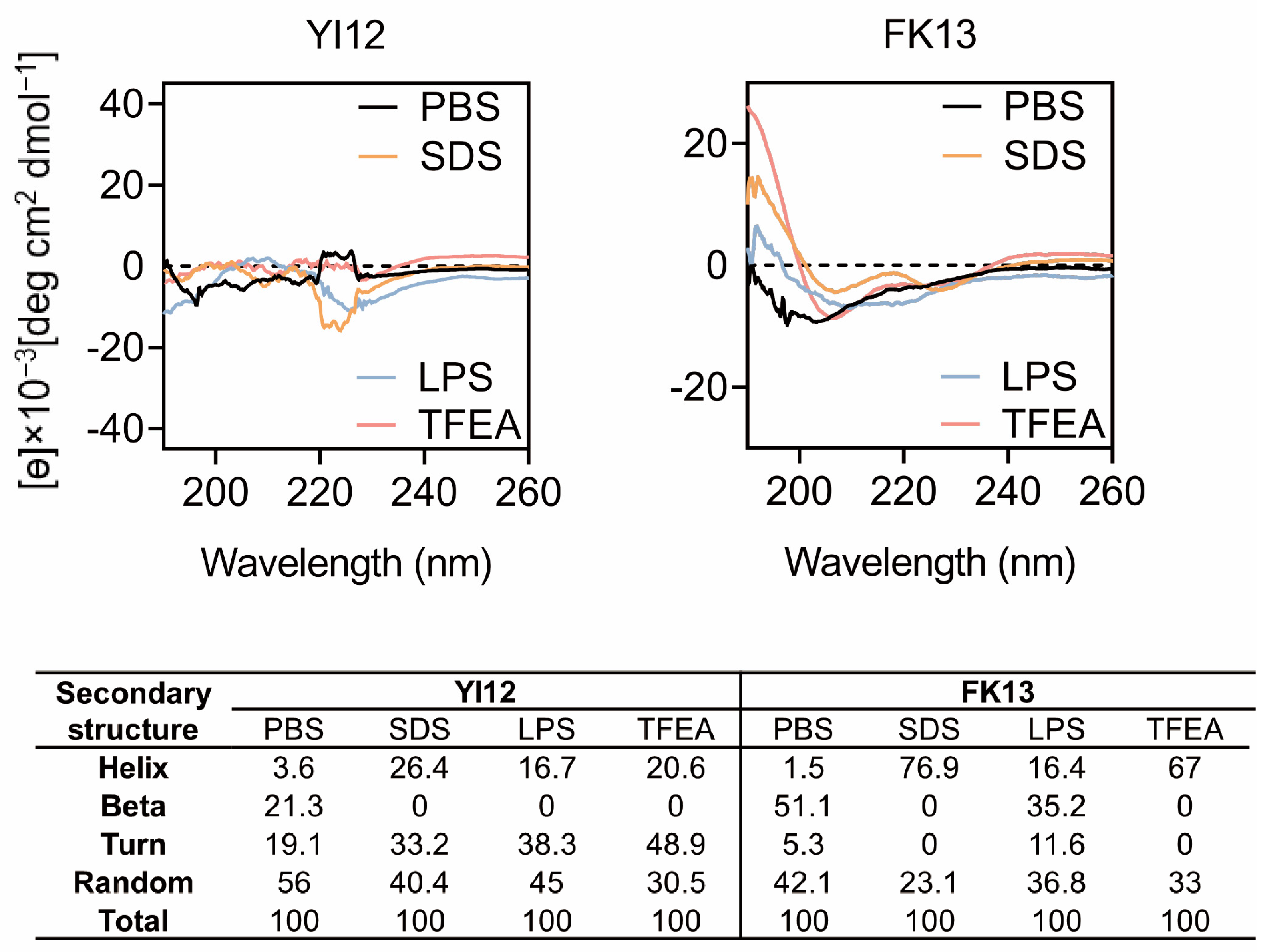
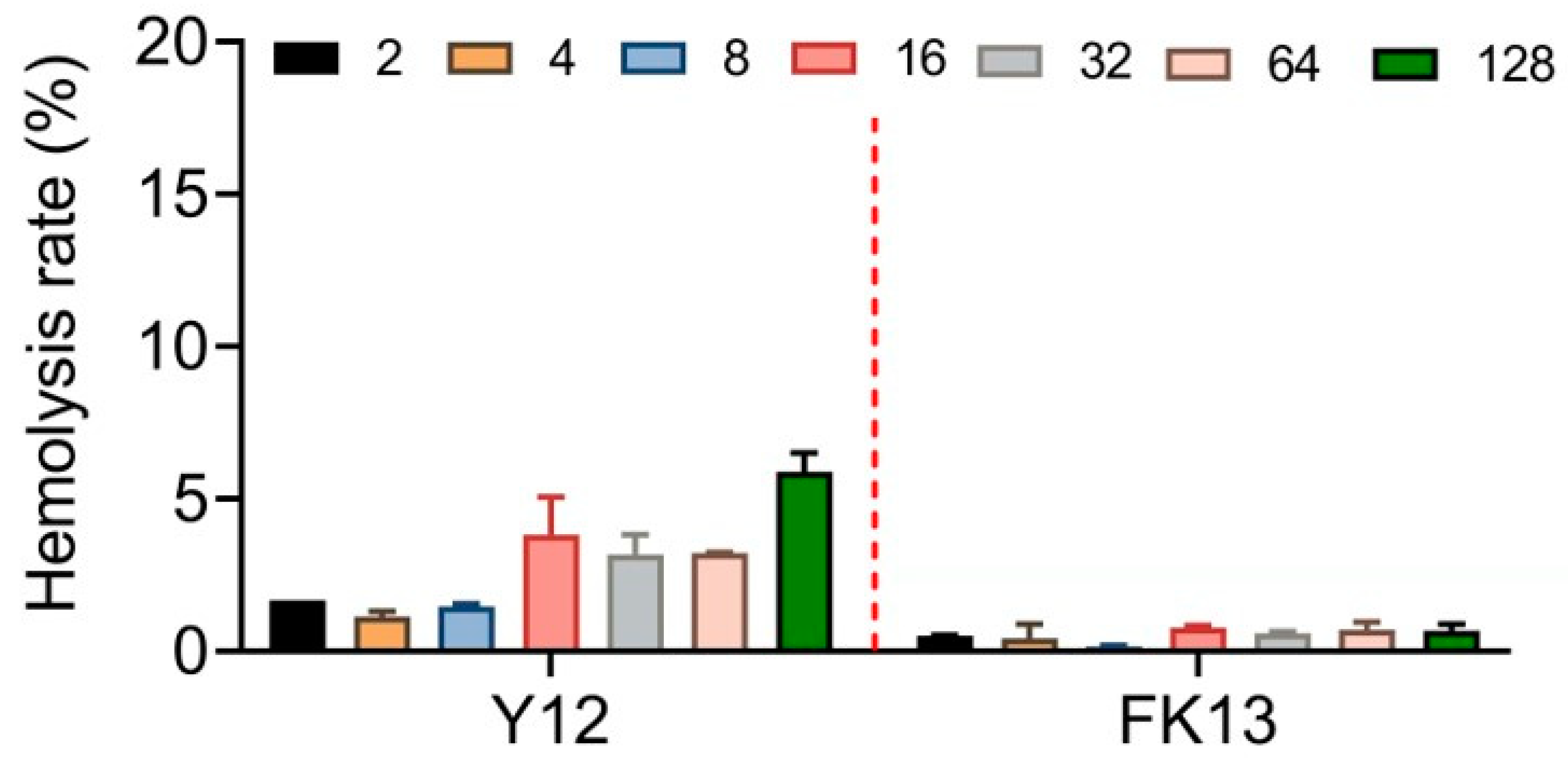
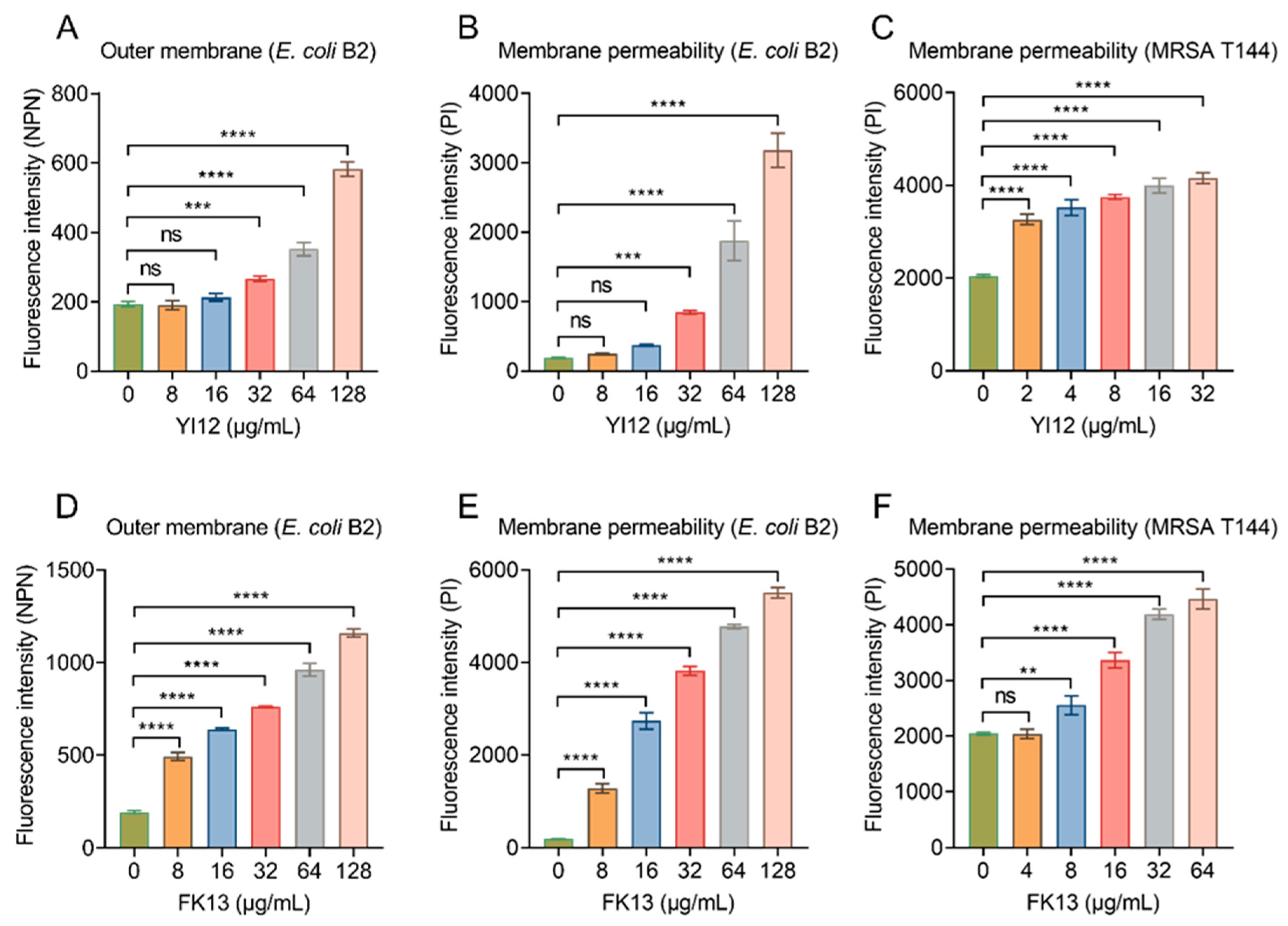
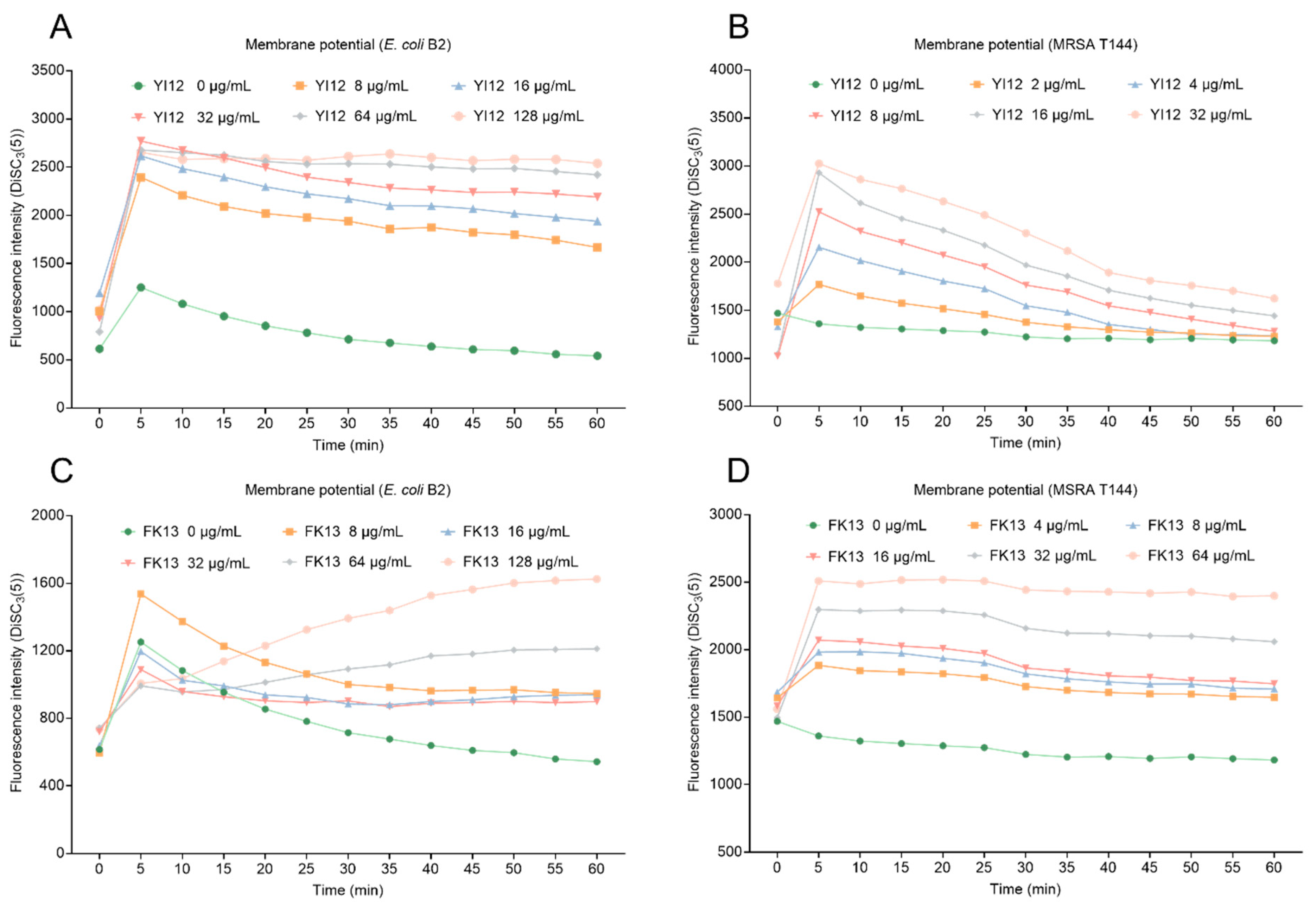
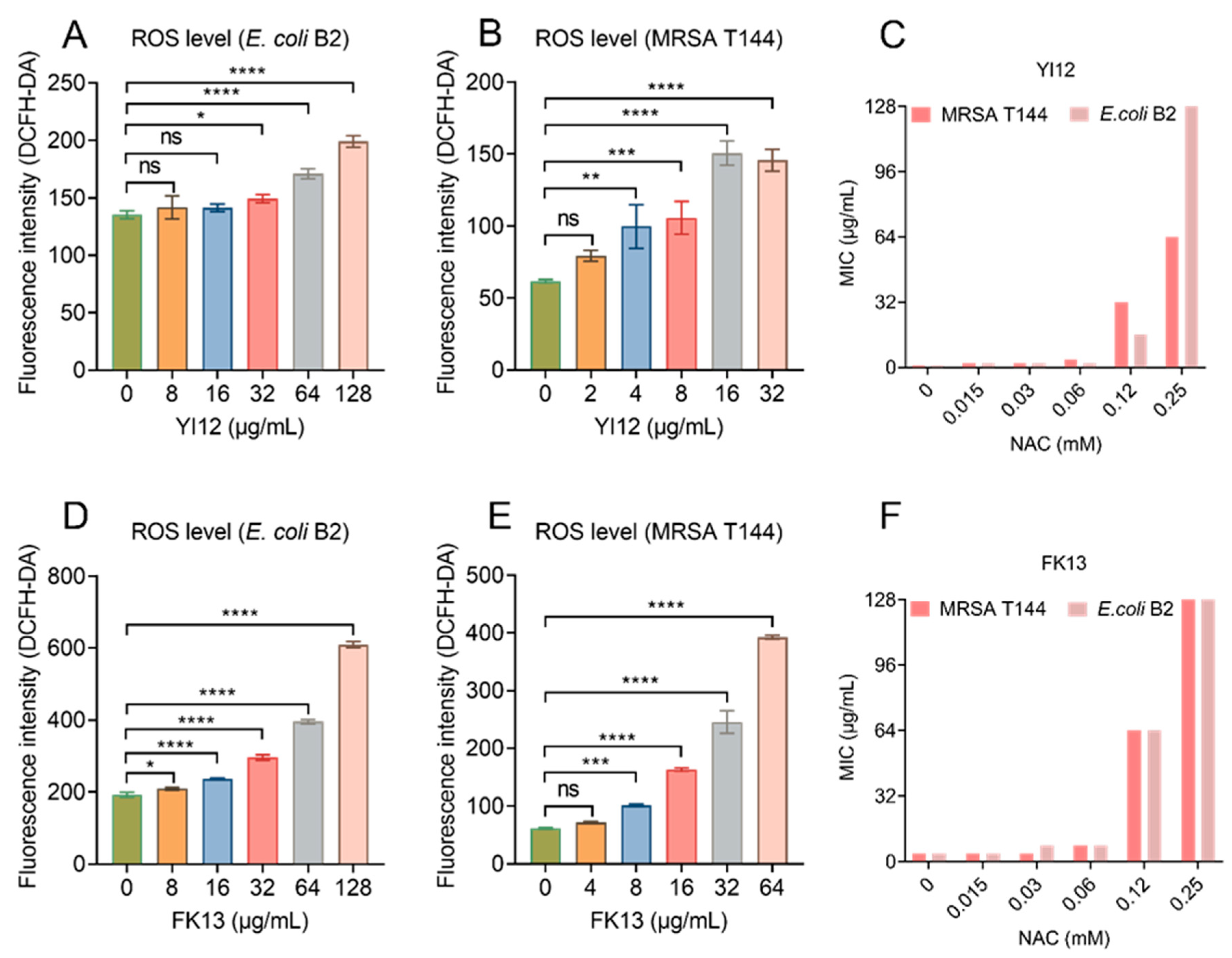
| Name | Sequence (N→C) | Formula | MW | Net Charge | pI # | Purity (%) |
|---|---|---|---|---|---|---|
| YI12 | YLRLIRYMAKMI-NH2 | C73H123N19O15S2 | 1571.72 | +3 | 10.28 | 96.73% |
| FK13 | FPLTWLKWWKWKK-NH2 | C98H135N21O15 | 1847.28 | +4 | 10.48 | 95.23% |
| Organisms | Phenotypes | YI12 | FK13 |
|---|---|---|---|
| S. aureus ATCC 29213 | G+, sensitive | 2 | 4 |
| MRSA T144 | G+, methicillin-resistant | 2 | 2–4 |
| E. coli ATCC 25922 | G−, sensitive | 8 | 8 |
| E. coli MG1655 | G−, sensitive | 2 | 4 |
| E. coli B2 (mcr-1 + blaNDM-5) | G−, colistin/carbapenem-resistant | 4 | 4–8 |
| P. aeruginosa PA14 | G−, ampicillin-resistant | 8 | 2 |
| S. enteritidis ATCC 13076 | G−, sensitive | 8 | 4 |
| A. baumannii ATCC 19606 | G−, sensitive | 2 | 4 |
| K. pneumoniae ATCC 700603 | G−, sensitive | 16 | 16 |
| Treatments | YI12 | FK13 | ||
|---|---|---|---|---|
| MRSA T144 | E. coli B2 | MRSA T144 | E. coli B2 | |
| Control | 2 | 4 | 2 | 4 |
| Temperature | ||||
| 40 °C | 4 | 4 | 2 | 8 |
| 60 °C | 4 | 8 | 2 | 8 |
| 80 °C | 4 | 8 | 2 | 8 |
| 100 °C | 4 | 4 | 2 | 8 |
| 121 °C | 4 | 4 | 2 | 4 |
| pH | ||||
| 2 | 2 | 8 | 4 | 4 |
| 4 | 2 | 4 | 4 | 4 |
| 6 | 2 | 4 | 2 | 4 |
| 8 | 2 | 4 | 2 | 4 |
| 10 | 2 | 8 | 2 | 4 |
| 12 | 4 | 8 | 2 | 4 |
| Salts (10 mM) | ||||
| NaCl | 2 | 16 | 4 | 4 |
| KCl | 8 | 4 | 16 | 4 |
| MgCl2 | 4 | >128 | 16 | >128 |
| CaCl2 | >128 | >128 | >128 | >128 |
| Protease (1 mg/mL) | ||||
| Pepsin | 64 | 64 | 64 | 64 |
| Trypsin | 64 | >128 | 64 | >128 |
| Papain | >128 | >128 | >128 | >128 |
| Serum (10%) | 4 | 32 | 16 | 32 |
| DMEM (10%) | 64 | 16 | 8 | 16 |
Disclaimer/Publisher’s Note: The statements, opinions and data contained in all publications are solely those of the individual author(s) and contributor(s) and not of MDPI and/or the editor(s). MDPI and/or the editor(s) disclaim responsibility for any injury to people or property resulting from any ideas, methods, instructions or products referred to in the content. |
© 2024 by the authors. Licensee MDPI, Basel, Switzerland. This article is an open access article distributed under the terms and conditions of the Creative Commons Attribution (CC BY) license (https://creativecommons.org/licenses/by/4.0/).
Share and Cite
Sun, J.; Kong, P.; Shi, J.; Liu, Y. Evaluation of the Antibacterial Potential of Two Short Linear Peptides YI12 and FK13 against Multidrug-Resistant Bacteria. Pathogens 2024, 13, 797. https://doi.org/10.3390/pathogens13090797
Sun J, Kong P, Shi J, Liu Y. Evaluation of the Antibacterial Potential of Two Short Linear Peptides YI12 and FK13 against Multidrug-Resistant Bacteria. Pathogens. 2024; 13(9):797. https://doi.org/10.3390/pathogens13090797
Chicago/Turabian StyleSun, Jingyi, Pan Kong, Jingru Shi, and Yuan Liu. 2024. "Evaluation of the Antibacterial Potential of Two Short Linear Peptides YI12 and FK13 against Multidrug-Resistant Bacteria" Pathogens 13, no. 9: 797. https://doi.org/10.3390/pathogens13090797
APA StyleSun, J., Kong, P., Shi, J., & Liu, Y. (2024). Evaluation of the Antibacterial Potential of Two Short Linear Peptides YI12 and FK13 against Multidrug-Resistant Bacteria. Pathogens, 13(9), 797. https://doi.org/10.3390/pathogens13090797







